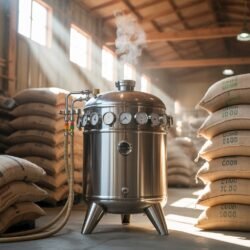Carbonic maceration in coffee fermentation is an innovative processing technique inspired by winemaking, specifically the Beaujolais region of France, where whole grapes are fermented before crushing to create unique flavor profiles. In coffee, this method involves placing whole, undamaged coffee cherries into an airtight vessel—often stainless steel or food-grade plastic—which is then flushed with carbon dioxide (CO₂) to create an oxygen-free, CO₂-rich environment.
Unlike conventional anaerobic fermentation, where cherries or beans ferment in their own naturally produced CO₂, carbonic maceration specifically introduces extra carbon dioxide at the start, often by pumping it into the sealed container. This CO₂-rich atmosphere encourages intracellular fermentation: the cherries begin to break down from the inside out, as enzymes within the fruit itself start fermenting the sugars before external microorganisms can act. The intact skin of the cherry prevents most microbes from accessing the fruit, so the initial fermentation is driven by the fruit’s own enzymes and the unique metabolic pathways favored under CO₂ pressure.
This process can last from several days to even months, depending on the desired flavor outcome. The controlled environment allows producers to manipulate variables such as temperature and pH, giving them greater control over the fermentation and the resulting flavor profile. The technique is known for producing coffees with intense, wine-like flavors, often featuring bright acidity, pronounced fruitiness (especially red fruits), and a complex, sometimes boozy or cooked-fruit character. If not managed carefully, however, the process can also risk astringency, dryness, or bitterness.
In summary, carbonic maceration in coffee is a specialized form of anaerobic fermentation where whole cherries are fermented in a CO₂-flushed, oxygen-free environment, resulting in distinctive, bold, and often wine-like flavor profiles.


